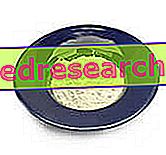The term cren can have two similar but not overlapping meanings. In the first case, the noun indicates a particular vegetable with a long root, better known as horseradish, horseradish rusticano or German horseradish; in the second, the name cren refers to a very particular sauce that is derived from the already mentioned plant.

Cren plant
The horseradish ( Armoracia rusticana, Cochlearia armoracia L.) is a plant that uses a long edible and typically aromatic root; also the leaves are edible, but are less used.
It is a perennial plant, meaning that it does not die with the seasons. It grows spontaneously also in Italy (central and north), in the countryside, where it is easily recognizable especially during flowering (small white flowers); obviously (as with many roots) in this period it is not advisable to eradicate it (flowering compromises the root trophism) and it would be appropriate to remember its location in order to take it in the autumn months.
The horseradish can also be cultivated; it does not like drought, water stagnation and likes fertile soils fertilized with vegetable macerates. The plant is typical of Central Europe, but different types of horseradish are present in all the continents of the globe.
The horseradish root, called "a fittone", finds numerous applications in the phytotherapeutic and gastronomic sectors. It is considered one of the most famous spicy foods (even if the sensations it conveys have little to do with chilli or black pepper) and its taste is almost acrid, the smell is pungent, while the volatile oil contained in the root it burns the eyes much more than the common onion (in addition to the Italian sauce, which we will see below, another condiment made from horseradish is wasabi ).
Cren sauce
The horseradish sauce is a product made from the processing of horseradish root. This should be picked in autumn, when it is succulent, trophic and full. It should therefore be peeled, grated and mixed with crumbled white bread (1/3 compared to the root used), white wine vinegar or apple vinegar (1/3 or 1/4 compared to the root used), extra virgin olive oil (1 / 8 compared to the root used), sugar (QB) and salt (QB).
The horseradish sauce is perfect for accompanying meat dishes, especially boiled, but also smoked and grilled; quite used in northern Italy, the horseradish sauce has its roots in the Central European cuisine (in which it is also used to grate the fresh root, eat it preserved in vinegar or sprinkle it with powder).
Homemade Cren
Cren sauce
X Problems with video playback? Reload from YouTube Go to Video Page Go to Video Recipes Section Watch the video on youtubePhytotherapy properties and nutrition
For external use, horseradish is used in dermatoses and herpes, but can be quite irritating for sensitive skin. Moreover, thanks to the remarkable vasodilating capacity, it seems that the cren for topical use can favor the improvement of symptoms related to tendinitis or superficial joint pains, such as epitrocleitis, tendinitis of the knee, rheumatism, etc.
Beyond the particular taste, which makes it an excellent substitute for pepper or mustard, the horseradish is recommended in the phytotherapy field for:
- Adjuvant treatment of urinary tract infections (diuretic and antimicrobial effect) and of parasitic bowel disease (vermifuge)
- Its eupeptic activity (promotes digestion by stimulating the secretion of gastric juices and bile action)
- Its expectorant activity (useful, for example, in the presence of bronchitis and fat cough).
The most significant and biologically active components of the horseradish are the sulfur glycosides (or glucosinolates ), themselves tasteless and odorless, turning into isothiocyanates (by enzymatic hydrolysis) acquiring a particularly pungent aroma and the characteristic spicy taste. These same molecules, according to some in-depth analyzes (however not yet complete), would seem to be implicated in the inactivation of certain carcinogenic compounds even if, on the contrary, in considerable quantities, glucosinolates could annoy the thyroid activity reducing its functionality. Cooking should definitely inactivate them but, for safety, hypothyroidism is not recommended for frequent, systematic and abundant use.
The horseradish has no particularly interesting nutritional properties. It has a considerable concentration of water, while vitamins (tendentially water-soluble, especially C) and mineral salts (in particular potassium and sodium) are almost all present in medium quantities. The fibers are abundant, but the energy macronutrients do not reach sensitive levels.
However, we remind you that the use of horseradish is not recommended for those suffering from renal impairment and is not recommended (or suggested in moderation) in young children, pregnant women and nurses.
Furthermore, the use of cren orally can still cause gastrointestinal disorders due to irritation of the mucous membranes; by the same principle, horseradish is contraindicated in cases of gastric and duodenal ulcers. Last but not least, the horseradish is not suitable for feeding people with hypothyroidism.



